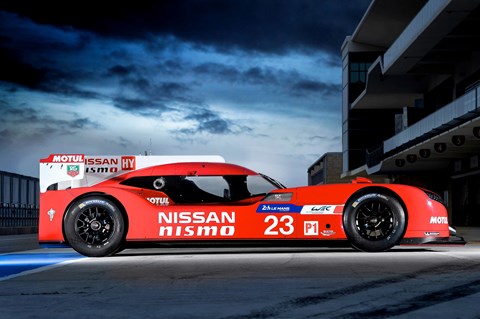► Nismo boss Darren Cox on Le Mans 2015
► Can revolutionary approach pay off?
► Expectations cautious; focus on 2016
Earlier this week, news broke that Nissan’s radical front-engined GT-R LM Nismo Le Mans racer had encountered development woes, forcing the withdrawal from the opening two rounds of the 2015 World Endurance Championship. Nissan has refused to deny comments it's failed a crash test.
It’s an inconvenient setback for the forward-thinking, forward-driven design, but not the end of the world, the company insists. While it will forego the first official WEC test and the curtain-opening races at Silverstone and Spa, it’ll still be ready for the all-important Le Mans 24 Hours in June. And after all, that’s the race that matters.
Le Mans: the goal
In a recent visit to CAR’s HQ just prior to the crash test debacle, Nissan’s head of global motorsport, Darren Cox, explained that while the World Championship as a whole is undeniably important, the La Sarthe classic has to be Nissan’s central goal, from both a results and marketing perspective.
‘2016 is our best shot,’ he said. ‘The first year has to be credible. We should qualify ninth because we’re the new boys and there are eight established contenders. Top six would be good.’
The first two rounds were always going to be a mileage-gathering exercise, in any case. The team had planned to run the car in its Le Mans aerodynamic configuration at both Silverstone and Spa to gather data ahead of the all-important 24 hours, Cox told us.
Nissan’s targets for 2015
From a marketing point of view, Nissan aims ‘to have a bigger share of voice than other manufacturers, and to have people talking about it.’ Cox won’t be drawn on fixed goals for the front-wheel drive GT-R LM Nismo Le Mans car. ‘Porsche didn’t find it easy [in 2014] - and probably had a year more than Nissan to prepare,’ he cautioned.
Nissan will field three cars rather than two at Le Mans, despite the increased costs involved. ‘It’s not worth not having another one,’ Cox said. ‘How many times has Audi won with just one car [left in contention at the end]?

‘There will be 11 works cars in this year’s Le Mans 24 hours. Somebody will have a trouble-free run.’ But likewise, he argues that the increased number of cars in contention, and the flat-out sprint nature of modern endurance driving, means there’s a greater chance of door-to-door racing and mishaps through contact.
Could Nissan just squeak through?
A history of risk-taking
Nissan isn’t averse to being daring with its motorsport projects. Supporting the radical Deltawing project in 2012 and putting Nissan branding on the car ‘was a big risk’, admitted Cox. ‘Every single manufacturer around the world was asked to provide an engine for the Deltawing car. They all said no, except Nissan.’
But the car’s anti-traditionalist, underdog status turned the brand into ‘heroes’, he contended.
Two years later, Nissan returned to Le Mans with the Zeod RC, an all-electric development of the Deltawing project. That car made Nissan the first manufacturer to complete an all-electric lap of La Sarthe, and also the first to reach 300km/h (186mph) under electric power alone. But far from 24 hours, it hit problems in the race after 24 minutes. ‘You could argue it was a failure, but sometimes to innovate you have to fail,’ said Cox.
There remains an inherent marketing value in the car, which still tours around the world at publicity events, and the project accelerated Nissan’s knowledge of battery technology.
Thinking ahead
It’s hard not to be enthused by the sheer creativity of the thinking behind Nissan’s endurance challenger. Its innovative approach, and the canny marketing activity around the car, has already built a high level of interest and support from fans far beyond the usual sphere of hardcore motorsport enthusiasts. Here’s hoping Nissan can get back on track, literally and metaphorically, in time to spring a surprise at La Sarthe in June 2015.
Missing the opening rounds does at least allow the team to continue intensive testing and development work – four days of which were sacrificed earlier in the year to film the Super Bowl advert which introduced the unusual Nismo LMP1 car to the world. Result? That campaign did ‘make the car a star in our biggest market,’ Cox argued.
‘Motoring in general is risk mitigation,’ he said. ‘[In the road car world], even building a Golf copy is a risk. You need to have belief in what you’re doing, but be willing to change tack if you have to.
‘Innovation hurts at the end of the day,’ he told CAR, portentously. ‘But if you can’t innovate in motorsport, you can’t do it at all.’
Read more about the amazing Nissan GT-R LM Nismo here.